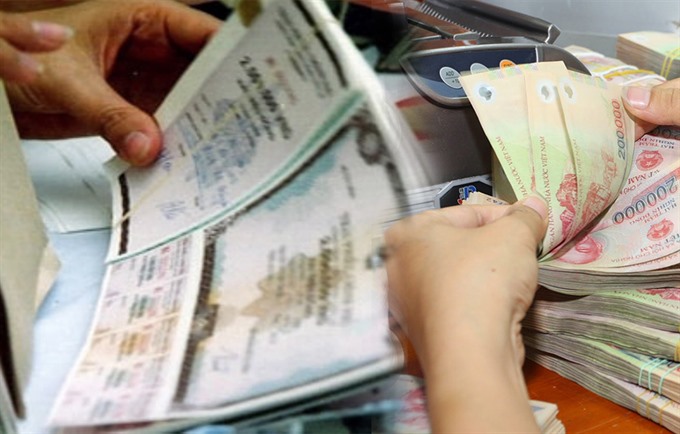 Economy
Economy

As of December 7 the treasury had raised more than VNĐ280 trillion by auctioning Government bonds, achieving the target for the year.
 |
By Thiên Lý
As of December 7 the treasury had raised more than VNĐ280 trillion by auctioning Government bonds, achieving the target for the year.
But the money raised has been used at a slow pace.
According to a recent announcement by the Việt Nam State Treasury, as of November only VNĐ659.39 billion (US$29.6 million) had been used, without including debt repayment, provision of aid, additional expenditure and risk provision. The amount accounted for only 78.8 per cent of the year’s spending estimate.
Of the figure, capital expenditure was VNĐ217.51 billion, making up only 64.3 per cent, much lower than in the same period the previous year.
The Ministry of Transport is one of the ministries that did not use even half the amount allocated for 2016.
In fact, it was allocated VNĐ25 trillion raised from Government bond issuances, but has to date spent only 40 per cent of it.
This is diametrically opposite to the situation that existed until a few years ago when ministries would clamour for more funds, which would often not be forthcoming.
Most sectors had great demand for funds to carry out their projects.
A treasury official said the agency was always ready to provide money for projects that merited then. Why then was the disbursement too slow last year?
Many analysts this on the slow progress of public investment plans due to tortuous investment and construction procedures.
There are overlapping, inconsistent, incompatible and even contradictory regulations in documents guiding implementation of the Investment Law and in investment decrees.
Another reason is that the Law on Public Investment took effect only in 2016, meaning many ministries and agencies were struggling to fully understand its sub-laws.
Faced with the situation, the Government issued Decree No 60/NQ-CP on major tasks and solutions to accelerate implementation of and release of funds for public projects.
It requires all ministries and local authorities to review and perfect legal frameworks so that they dovetail with the country’s laws and quickly remove all hindrances to speed up disbursement of funds for public projects to ensure they proceed on schedule.
The treasury for its part has promised to release capital for qualified projects within four days.
Though the Civil Code enacted in 2015 took effect over a week ago many banks are confused about its provisions due to a lack of guiding documents.
The problem arises from the fact that the financial market is now regulated by two different laws, the other being the Law on Credit Institutions.
While the Law on Credit Institutions allows banks to negotiate lending interest rates with borrowers, the Civil Code caps interest rate at 20 per cent.
They are thus understandably unsure about which lending rate to apply to not fall foul of the law.
Some experts said the lending rate cap applies to banks, credit institutions and co-operatives offering consumer finance and loans.
Consumer finance includes mortgages and loans for all kinds of consumer goods, and also refers to loans given at prime and subprime rates.
Banking industry insiders said the interest rate cap in the Civil Code applies only to loans given by private moneylenders.
But others said that according to the Civil Code, if the negotiated interest rate exceeds 20 per cent, the rate would not come into effect and would be superseded by the 20 per cent cap.
The Law on Credit Institutions says credit institutions can negotiate the lending interest rates with their customers, but must be done within the purview of the Civil Code.
Analysts said imposing a 20 per cent interest rate cap on loans is too arbitrary because credit institutions offer consumer loans mainly to low-income earners without collateral and against just the borrower’s signature, and so suffer high risk.
Because of this, most credit institutions to charge interest rates of 20-24 per cent to offset possible losses.
Besides, they pointed out that it is not necessary to have a cap since credit institutions apply loan interest rates based on interest rates on short-term deposits.
In a market economy, they are kept in check by competition and laws of supply and demand, and so cannot fix rates at a level the market would not countenance, they said.
However, to make things straightforward for both lenders and borrowers, entities like the National Assembly’s Standing Committee, Supreme People’s Court, and the State Bank of Việt Nam should issue explanatory documents and circulars that provide necessary guidelines.
The analysts said that in the long term, interest rate liberalisation is a policy that should be targeted.
In December Thế giới Di Động Joint Stock Company opened an outlet of its Xanh electronic chain on Huỳnh Tấn Phát Street in HCM City’s Nhà Bè District.
The store is only around 400sq.m including the parking lot. This is the 28th Xanh outlets in the city, many of them mini stores, a model the company adopted last June.
Thế Giới Di Động is unlike other electronic retailers in that most of its shops are less than 1,000sq.m.
Its mini stores have mushroomed nation-wide.
At the end of last year Thế Giới Di Động had a total of 249 Xanh outlets, a majority of which are mini stores.
Thiên Nam Hoà Company, another established electronics retailer, is going down the same path, recently opening a 1,000sq.m store in Bình Dương Province’s Bến Cát town.
This is also much smaller than its other stores openned before, most of which are large and situated on major streets in HCM City’s districts 10 and Tân Phú.
Since last July Thiên Nam Hoà has been opening mini stores, with the first one in District 7. The company plans to open 10 of them this year.
Another well-known electronics store, Nguyễn Kim, opened 14 new mini outlets on December 9, eight of them in Big C supermarkets. The company is expected to expand its chain of small stores from the current 34 nation-wide to 50 by 2019.
Nguyễn Kim’s mini outlets measure around 300sq.m, much smaller than its original stores.
Chợ Lớn Electronics and Interiors Supermarket now has 44 stores, many of them mini stores situated between Đà Nẵng and the south.
Market observers said many electronics retailers are vying with each other to open mini stores.
The reason that even large, established players like Thiên Nam Hoà, Nguyễn Kim and Chợ Lớn are going down this route is the strong recovery in the market.
Thus, Thế Giới Di Động’s Xanh mini stores have helped the company quadruple its turnover in 2016.
Thế Giới Di Động spokesperson revealed that the company expected turnover to double and profits to rise by 2.5 times this year.
Another reason to embrace the mini store model is that it allows easy adjustment of business plans to make optimum use of investments. — VNS




